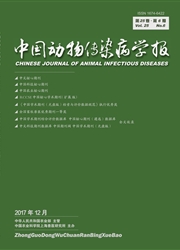

 中文摘要:
中文摘要:
根据ClassI新城疫病毒分离株9a5b编码序列设计特异性引物扩增P蛋白基因,原核表达后利用纯化的蛋白免疫BALB/C小鼠制备单克隆抗体,经二次亚克隆后筛选到4株针对P蛋白的单克隆抗体,利用所得单抗进行P蛋白在细胞内定位分析,NDV9a5b株按5M.O.I感染量接种DFl单层细胞,当PI=4h时,P蛋白呈点状弥散分布于细胞浆内;PI=6~8h时,P蛋白聚集于细胞核周围;PI=12h时,P蛋白呈单极化聚集于细胞核一侧;而PI=16h后开始形成合胞体,P蛋白在单个细胞中仍呈现单极分布;当PI=48h时,细胞核已发生碎裂,荧光强度有所减弱。本研究为深入开展P蛋白在病毒增殖以及细胞周期中的作用机制研究奠定了基础。
 英文摘要:
英文摘要:
According to the sequence of Class I Newcastle disease virus (NDV)9a5b strain, a pair of primes was designed to amplify P genes. After procaryotic expression and purification, P protein was immunized BALB/c mouse to prepare monoclonal antibodies (MAbs). After subcloning for 2 times, 4 specific MAbs were obtained to analysis the subcellular localization of P protein. The DF-1 monolayer cells were infected by 5 M.O.I NDV 9a5b virus. PI=4 h, P protein diffusely distributed in cytoplasm in punctiform. PI=6-8 h, P protein accumulated mainly in the surrounding of nucleus. PI=12 h, P protein localized in the monopole of cells. After the formation of syncytium in 16 h, P protein still accumulated mainly in the monopole of single cells. PI=48 h, with the cell nucleus splitting up, fluorescence intensity attenuated. The research established the basis for further study on the effect P protein participated in virus generation and cell cycle.
 同期刊论文项目
同期刊论文项目
 同项目期刊论文
同项目期刊论文
 期刊信息
期刊信息
